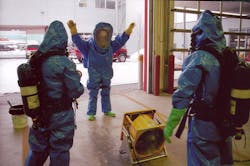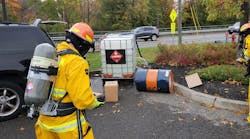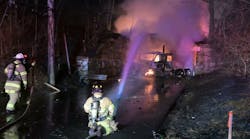Decontamination is essential when faced with the contamination of civilians, military personnel or emergency responders as the result of an accidental or intentional contamination by hazardous materials or weapons of mass destruction. But different agencies have different ways of defining decontamination beyond the basics:
- Occupational Safety and Health Organization (OSHA): “Decontamination is the process of removing or neutralizing contaminants that have accumulated on personnel and equipment.” (Note: This is sometimes referred to as technical decontamination.)
- Department of Homeland Security (DHS): “Any process, method or action that leads to a reduction, removal, neutralization—by partitioning or binding (as opposed to chemical neutralization, which is not recommended)—or inactivation of contamination on or in the patient in order to prevent or mitigate adverse health effects to the patient; protect emergency first responders, healthcare facility first receivers, and other patients from secondary contamination; and reduce the potential for secondary contamination of response and health care infrastructure.”
- Centers for Disease Control (CDC): “The reduction or removal of radioactive contamination from a structure, object or person. Decontamination is a part of hazmat response team operations.”
Further, according to National Fire Protection Association (NFPA) Standard 472, a hazmat response team is an “organized group of trained personnel operating under an emergency response plan and appropriate standard operating procedures who handle and control actual or potential leaks or spills of hazardous materials requiring possible close approach to the material. The team members respond to releases or potential releases of hazardous materials for the purpose of control or stabilization of the incident.”
Decontamination is an important step in protecting emergency personnel and the public during a hazmat or terrorist incident. Decon provides protection for victims, including emergency responders, who have become contaminated without the benefit of proper protective clothing. It also protects responders who have entered an incident scene with proper protective clothing by removing any harmful materials that they may have contacted during operations. The longer harmful materials contact the body, the more damage that is done. Therefore, the quicker decontamination can be performed, the quicker the damage can be limited or stopped. There are three basic types of decontamination: technical, emergency and mass.
Technical decontamination
Technical decon is established by hazmat team members or operations-level responders who have been trained for decontamination of the hazmat team exiting the hot zone. It may also include equipment decontamination as well. If there are not mass numbers of victims, additional technical decontamination lines can be set up for just the victims. Technical decontamination is set up before hazmat team members make an entry.
The Center for Domestic Preparedness at Fort McClellan, AL, uses the “good, better, best” concept for decontamination solutions. Water is good, soap and water is better, and chlorine bleach solutions are best when dealing with chemical or biological agents. Chlorine bleach is widely accepted in military and civilian sectors for decontamination of chemical and biological agents, although it is not without dangers when used on people. Chlorine can cause damage to the skin and blindness if splashed in the eyes
Technical decontamination generally involves the use of a “corridor” (sometimes referred to as a “contamination reduction corridor”) with a gross contaminant reduction section followed by a series of wash-and-rinse stations, an undressing area and a rehabilitation area.
Technical decon operations take time to set up. If a community must wait for a hazmat team to respond from a remote location, the setup is delayed even longer. While the response and setup of technical decon is taking place, chemicals are continuing to harm victims. While the concept of emergency decon for terrorism is well established, I am not sure all first responders realize that the same tactics can be used for other hazardous materials. Many training programs for first responders do not even mention emergency decon as an option. In fact, I think many times we instill so much fear into first responders that they do not want to do anything with victims. It makes no sense to force people who have been splashed with an acid or other harmful chemical to wait for a hazmat team to set up technical decon before the materials can be removed from their bodies.
Emergency decontamination
Response protocols for hazmat incidents have identified the duties of first responders as isolation, notification, protection and identification. Protection includes PPE for responders and evacuation or sheltering in place for the public. Protection should also include emergency decon for contaminated victims. Emergency decon should be conducted as a defensive operation. Personnel conducting emergency decon, regardless of the circumstances, should be wearing full firefighter turnouts and SCBA. Decon operations should be located upwind and uphill from the contamination, and personnel should avoid contact with the persons contaminated and runoff from the decon operation.
Emergency decon can be accomplished without the purchase of any additional equipment for first responders. Equipment used for emergency decon is already available on most fire apparatus. Typical fire apparatus carry rope, tarps and various types of nozzles and hoselines as standard equipment. Some additional inexpensive supplies to carry include soap, chlorine bleach solutions and some type of garment for victims once emergency decon takes place. Many of the supplies needed to complete decontamination can be purchased locally at hardware and discount stores. Fire departments usually have access to SCBA for respiratory protection. OSHA regulations permit decon teams to wear one level of protective clothing less than the entry team is wearing. Hazmat teams generally use Level A (total encapsulation) for vapor atmospheres or Level B (splash protection) for non-vapor atmospheres. As a result, the decontamination team will almost always be in Level B protection. Disposable Level B suits can be purchased for less than $100 per suit.
Emergency decon involves several steps:
- Wash down the victim with water while outer cloths are still on.
- Remove the victim’s outer clothing, leaving underwear in place. Clothing may contain the most contaminant, and keeping it on will prolong the contact of the harmful materials with the body.
- Wash down the victim again. With the second wash down, soap and water can be applied if soap is available. Liquid soap should be used because it dissolves better in cold water and dry soap can be abrasive.
- Provide victims with replacement clothing or coverings. This can be as simple as large plastic trash bags with holes cut in them, disposable sheets or blankets, hospital gowns or scrubs, used clothing from Goodwill or the Salvation Army, or commercially available paper clothing.
When outer clothing is removed, actions should be taken to protect the privacy of victims. Tarps used for salvage and ropes used in rescue operations can be employed to provide privacy curtains for decon. Ropes can be strung between the hose beds of apparatus placed back to back with spacing for the protected decon corridors. Tarps can then be placed over the ropes to provide privacy corridors for victims and can be used to segregate sexes. Nozzles can be placed on discharge ports of two engines side by side to provide a wide-angle fog for decontamination. The area between the engines can be used as a privacy protected corridor.
While there are important environmental concerns for the runoff from any type of decontamination, life safety of victims should be the first priority when conducting emergency decon. Runoff may contain contaminants that could harm the environment and every effort should be made to control it; however, the life safety of victims and responders takes precedence. First responders should not take time to worry about runoff at the expense of the victims’ well-being.
The U.S. Environmental Protection Agency (EPA) has issued guidance for emergency decontamination of victims of terrorist agents, which reflect the priority of victims and then protect the environment as soon as possible after life safety has been addressed. This same guidance may be applied to hazmat incidents. Once again, tarps and salvage covers could be used to aid in runoff control, if time permits. Dirt and other materials found at an incident site can also be used to help control runoff.
Mass decontamination
Mass decon is required when large numbers of victims have been exposed to contamination, which needs to be removed as quickly as possible. Mass decontamination can be performed in conjunction with emergency decontamination if a technical decon has yet to be established. Once resources have arrived on scene, a more organized mass decontamination can be performed on victims. This may involve mass decontamination trailers or large mass decontamination tents with roller assemblies to take care of non-ambulatory patients.
With large numbers of people, decontamination may be accomplished with a combination of systems. Large numbers of victims are going to be difficult to handle at best. Do not become overwhelmed. Take care of victims one at a time. Training with equipment and conducting realistic drills will help make an actual incident run smoother.
Technical decon may also be set up to deal with decontamination of response personnel. All three types of decon may be in operation at one time depending on the circumstances of an incident.
Training and resources
The process of decontamination is not overly technical, nor does it require the purchase of lots of expensive equipment or training personnel to the technician level. While traditionally technician-level personnel from hazmat teams have conducted decon, many fire departments train and equip specialized decon teams with personnel who have operations-level hazmat training and provide them with training for decontamination. This is an acceptable procedure under OSHA regulations. OSHA's basic regulatory philosophy is to train and equip employees to do the job they are asked to do. A decon team should have a response plan and standard operating procedures (SOPs) to establish protocols for decon operations, including emergency decon. Jurisdictions that choose to operate with first responder emergency decon should also have written procedures in place guiding the operations.
Many jurisdictions do not have their own hazmat teams; they require the use of mutual aid or private contractors for hazmat responses. Mutual-aid teams and private contractors generally do not respond with large numbers of people, but a simple entry into a hazmat hot zone and resulting decon can easily require 20 to 30 personnel. So the idea of a local designated decon team can provide additional personnel to assist the mutual-aid hazmat team. This concept can also work well in departments that have hazmat teams because in both cases, decon teams will free technician-level personnel on the hazmat team to concentrate on entry operations. A local decon team can provide ambulatory victim decontamination while waiting for the hazmat team to arrive. A local decon team can then provide technical decontamination for hazmat team members, thus freeing technicians for entry tactics and rescue of non-ambulatory victims.
Decon teams also must be trained. Training has a monetary value in terms of the cost of the training and in the cost of the time spent on the training. Decon training would require 16–24 hours, including theory and hands-on. Training should include elementary toxicology, decontamination solutions, decontamination setup, protective equipment and decontamination procedures. Toxicology is covered because the primary reason for decontamination is to remove toxic materials from victims and personnel. Being flexible and creative in establishing decontamination procedures can streamline operations, make better use of personnel, and provide better protection for responders and the public.
Some hospital emergency departments are not even prepared to deal with victims of accidental hazmat incidents. (Because agents used in terrorist attacks are hazardous materials, no differentiation is made in this column when referring to them when discussing procedures unless they are unique to a particular material.) Patients could contaminate a hospital emergency department and close it to other types of emergencies until it can be decontaminated. Much of the attention at a hazmat or terrorist scene is focused on treating victims and mitigating the incident. Response personnel also need to take into consideration treatment beyond the scene (i.e., the hospital and, in particular, the emergency room). Many hospitals, particularly smaller ones, are not prepared to accept potentially contaminated victims from a hazmat or terrorist incident. While it is not necessary that every hospital emergency department have the capability of receiving contaminated victims, response personnel should know which hospitals do have that ability. The successful outcome of a hazmat or terrorist incident will depend on good preplanning, which must include the local medical system. In addition to decontamination ability, hospitals should be identified that have the expertise to handle poison exposures, including stocks of antidotes. When a community has more than one hospital, certain ones may be designated as hazmat facilities for the purpose of receiving patients from the emergency medical system. All other hospitals should at least have the ability to provide basic decontamination and care for people exposed to hazardous materials.
In sum
Mass-casualty incidents involving hazardous materials may overwhelm all hospitals in a community. There may not be enough doctors and nurses, supplies, equipment or bed space to treat victims. Without a preplan that makes contingencies for mass-exposure incidents, the impact of the disaster on the community will only be compounded by the medical system. Once plans are developed, they must be practiced and personnel trained to follow them. Being flexible and creative in establishing decontamination procedures can streamline operations, make better use of personnel, and provide better protection for responders and the public.






